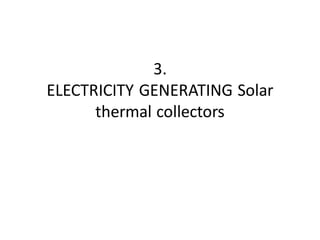The document discusses concentrated solar power (CSP) technologies that convert thermal energy from sunlight into electricity through various methods including parabolic troughs, dishes, and power towers. These systems use mirrors to focus sunlight, raise the temperature of a fluid to create steam, and drive turbines for electricity generation. CSP can serve as both flexible and baseload power sources, with applications for heat storage and reductions in fossil fuel use.



























![Concentrating solar power (CSP)
Source: S. Ong et. al 2013 [10]
Land Requirementfor Different CSP Technologies
Parabolic trough collector (PTC) , Liner Fresnel reflector (LFR), Paraboloid dish collector (PDC), Central Power Tower – heliostat (CPT or SPT),](https://image.slidesharecdn.com/solarthermal2-221102080500-9c9a330a/85/solar-thermal_2-pdf-28-320.jpg)










